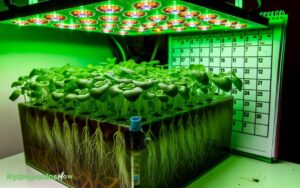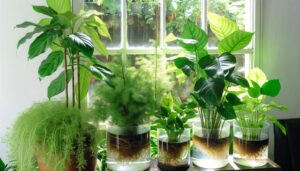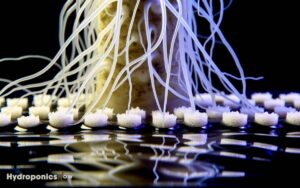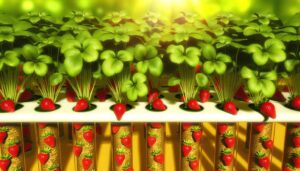Top 10 Advantages of Using Hydroponics and Aeroponics for Growing Plants
Hydroponics and aeroponics offer significant benefits in modern agriculture. These techniques guarantee faster plant growth by optimizing nutrient delivery and oxygen availability.
Space efficiency is achieved through vertical stacking and dense plant spacing, making them ideal for urban farming.
Both methods conserve water via closed-loop systems that recycle nutrient solutions, making them suitable for arid climates.
Higher yields are obtained due to enhanced nutrient uptake and accelerated growth cycles. Precision control over pH, nutrient levels, and moisture content ensures consistent, high-quality produce while minimizing pests and diseases.
For a thorough understanding of these advanced agricultural methods, further exploration is recommended.
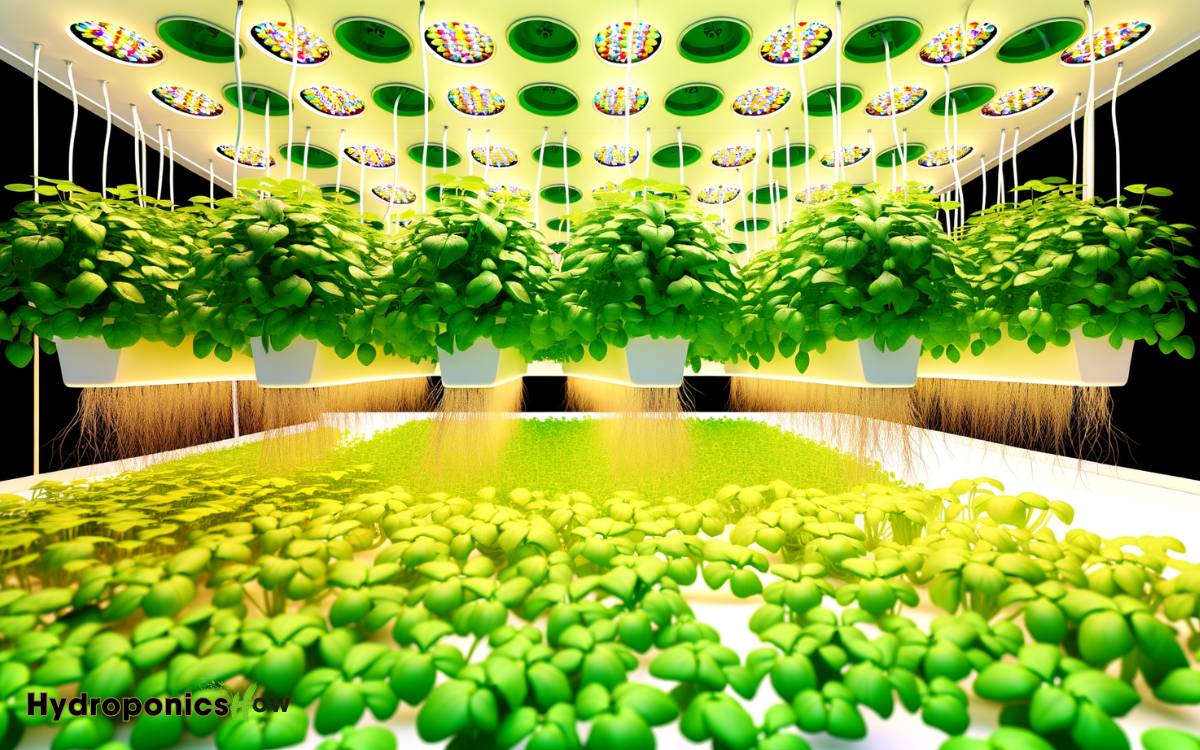
Key Takeaways
Faster Growth Rates
Using hydroponic and aeroponic systems can greatly increase plant growth rates due to the optimized delivery of nutrients and oxygen directly to the root zone. These advanced growing methods help maximize nutrient absorption, leading to healthier plants and higher yields. Additionally, incorporating fulvic effects in hydroponics can enhance nutrient uptake and improve root development, further boosting plant vitality. By maintaining precise control over growing conditions, hydroponic and aeroponic systems offer a sustainable and efficient solution for modern agriculture.
These systems bypass traditional soil constraints, allowing precise control over pH and nutrient concentrations.
Hydroponic systems use nutrient-rich solutions to guarantee that essential minerals are readily available, reducing the energy plants expend in root growth and nutrient acquisition.
Aeroponic systems further enhance this by misting the root zone, maximizing oxygen availability and promoting faster cellular respiration.
This increased efficiency results in accelerated growth cycles, enabling more frequent harvesting.
Additionally, the controlled environment reduces the risk of soil-borne diseases, enhancing overall plant health and vigor. Implementing these methods can lead to significant improvements in agricultural productivity.
Space Efficiency
Space efficiency is a critical advantage of hydroponic and aeroponic systems. These systems allow for vertical stacking and dense plant spacing, maximizing yield per square foot.
They leverage advanced techniques such as tiered structures and compact growth mediums, enabling cultivators to utilize available space more effectively than traditional soil-based methods.
This spatial optimization is particularly beneficial in urban agriculture and controlled environment agriculture (CEA), where real estate is limited and expensive.
By reducing the footprint required for cultivation, hydroponics and aeroponics facilitate higher productivity in smaller areas.
Additionally, the precise control of nutrient delivery and root aeration in these systems enhances plant health and uniformity. This further contributes to efficient space utilization and increased overall yield.
Water Conservation
In addition to optimizing spatial efficiency, hydroponic and aeroponic systems are renowned for their significant water conservation capabilities.
They employ closed-loop systems that recycle water and reduce overall consumption compared to traditional soil-based agriculture.
By continuously recirculating nutrient solutions, these methods minimize evaporation losses and guarantee precise delivery of water directly to plant roots.
This not only conserves water but also reduces the need for frequent irrigation, making these systems highly efficient.
Additionally, advanced sensors and automation in hydroponics and aeroponics can monitor and adjust water usage in real-time, optimizing resource utilization.
Consequently, adopting these techniques is particularly advantageous in arid regions or areas experiencing water scarcity, providing a sustainable alternative to conventional farming practices.
Higher Yields
Hydroponic and aeroponic systems are capable of producing much higher yields per unit area compared to traditional soil-based agriculture due to the enhanced control over environmental factors and nutrient delivery.
This increased productivity can be attributed to several key factors:
- Enhanced Nutrient Uptake: These systems deliver nutrients directly to the plant roots in a dissolved form, facilitating efficient absorption and minimizing waste.
- Accelerated Growth Rates: The precise regulation of light, temperature, and humidity creates ideal growing conditions, leading to faster plant development.
- Space Efficiency: Vertical farming techniques, often employed in hydroponics and aeroponics, maximize the use of available space, allowing for denser planting and higher output per square meter.
These advantages collectively contribute to considerably higher yields, making hydroponics and aeroponics highly efficient alternatives to conventional farming.
Precision and Control
Beyond achieving higher yields, hydroponic and aeroponic systems offer unparalleled precision and control over various environmental parameters, ensuring ideal growth conditions for plants.
These systems allow the meticulous regulation of nutrient delivery, pH levels, and moisture content, optimizing plant health and productivity.
Advanced sensors and automated systems enable real-time monitoring and adjustments, minimizing human error and environmental stress. The absence of soil eliminates variables such as pests and diseases, further enhancing control.
Additionally, controlled environment agriculture (CEA) techniques can be integrated, including artificial lighting and climate regulation, to simulate peak growth conditions year-round.
This precision fosters consistent, high-quality produce and maximizes resource efficiency, making hydroponics and aeroponics highly advantageous for modern agricultural practices.
Frequently Asked Questions
Can Hydroponics or Aeroponics Be Used for All Types of Plants?
While hydroponics and aeroponics can support a wide variety of plants, certain species, particularly deep-rooted and large woody plants, may face challenges due to their specific spatial and structural needs in these soilless cultivation systems.
What Are the Initial Setup Costs for a Hydroponic or Aeroponic System?
Proper budgeting guarantees successful implementation of hydroponic and aeroponic systems, with initial setup costs ranging from $50 to $500 for hydroponic systems and $200 to $1,000 for aeroponic systems.
Various factors such as system complexity, materials, and scalability requirements influence the overall costs.
How Do Hydroponic and Aeroponic Systems Affect Plant Nutrient Uptake?
Hydroponic and aeroponic systems enhance plant nutrient uptake by delivering a precise, balanced nutrient solution directly to the root zone.
This maximizes absorption efficiency, promotes rapid growth, and guarantees uniform nutrient availability, optimizing overall plant health.
Are There Any Potential Drawbacks to Using Hydroponics or Aeroponics?
While hydroponics and aeroponics offer efficient nutrient delivery, they require precise monitoring and control of environmental conditions. System failures, such as pump malfunctions, can rapidly lead to nutrient deficiencies, emphasizing the need for reliable backup systems and vigilant oversight.
How Do Plants Grown Hydroponically or Aeroponically Compare in Taste to Traditionally Grown Plants?
Plants grown hydroponically or aeroponically often exhibit comparable or superior taste to traditionally grown plants due to precise nutrient control and optimized growth conditions, although taste can vary depending on specific crop and cultivation techniques.
Conclusion
To sum up, hydroponics and aeroponics offer a fertile ground for agricultural advancement. They exhibit faster growth rates, space efficiency, water conservation, higher yields, and precise control over growing conditions.
These techniques stand as pillars of modern horticulture, creating a symbiotic relationship between technology and nature.
By harnessing these methods, sustainable agriculture can be achieved, paving the way for a bountiful and efficient future in food production.
The benefits of these systems are both profound and multifaceted, heralding a new era in plant cultivation.

